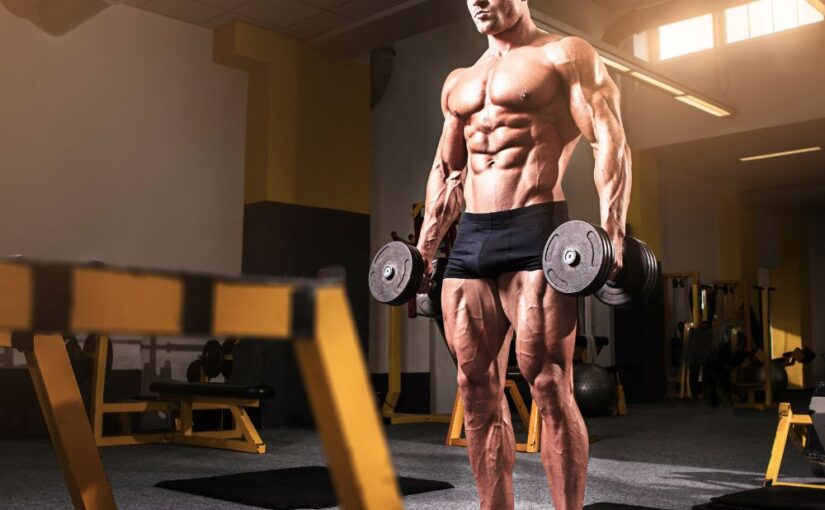When it comes to building muscle at home, dumbbells—much like barbells—are a popular and highly effective choice for many fitness enthusiasts. They offer versatility, convenience, and access to a wide range of effective exercises. However, a common question arises: are dumbbells enough to build muscle? This article explores the effectiveness of dumbbells in achieving these fitness goals and offers insights into maximizing their benefits.
The Benefits of Dumbbells
Below are some of the top benefits of using dumbbells to build muscle at home:
1. Versatility
Dumbbells allow for a wide variety of exercises targeting different muscle groups. From traditional lifts like bench presses and squats to isolation movements such as bicep curls and tricep extensions, dumbbells can effectively work all major muscle groups. Their flexibility makes them ideal for both novice and advanced lifters.
2. Improved Muscle Activation
Using dumbbells requires greater stabilization than using a barbell, as each arm works independently. This independence can enhance muscle activation and promote balanced strength development, helping to prevent muscle imbalances.
3. Range of Motion
Compared to fixed machines, dumbbells provide a greater range of motion. This flexibility allows for more natural movement patterns, which can lead to better muscle engagement and overall effectiveness during workouts.
4. Accessibility
Dumbbells are relatively affordable and can be easily stored at home, making them an accessible option for many people. Whether at the gym or in a home workout space, they can be used effectively to achieve fitness goals.
How to Build Muscle with Dumbbells
1. Progressive Overload
To build muscle and strength, you must apply the principle of progressive overload. This involves gradually increasing the weight you lift, the number of repetitions, or the intensity of your workouts. Dumbbells can accommodate this principle well, as you can easily adjust the weights to continue challenging your muscles.
2. Training Volume and Frequency
To effectively build muscle and strength, it’s important to consider training volume (the total amount of work done) and frequency (how often you train). With dumbbells, you can structure your workouts to include multiple sets and repetitions, allowing for sufficient volume to stimulate growth.
3. Incorporating Compound and Isolation Exercises
Dumbbells are effective for both compound and isolation exercises. Compound movements, such as dumbbell squats and chest presses, engage multiple muscle groups and are great for building overall strength. Isolation exercises, like lateral raises and tricep kickbacks, target specific muscles and can help enhance muscle definition.
Limitations of Dumbbells
While dumbbells are a powerful tool for building muscle and strength, they do have some limitations:
1. Weight Capacity
Dumbbells have a weight limit compared to barbells or weight machines. If you reach a point where the available dumbbell weights are no longer challenging, it may hinder further strength gains.
2. Stability Challenges
While the independence of dumbbells can enhance muscle activation, it can also pose stability challenges for beginners. Those new to strength training may struggle with form or experience difficulty with certain movements.
3. Imbalances
If one side of your body is stronger than the other, using dumbbells can highlight these imbalances. While this can be beneficial for correcting them, it may initially lead to frustration if one side fatigues more quickly.
These challenges can be addressed through progressive overload, smart programming, and the use of accessory lifts that target specific weaknesses.
Maximize Results by Pairing Dumbbells with Other Equipment
To maximize muscle gains, consider combining dumbbells with other training modalities:
- Barbells: Incorporating barbell exercises can allow for heavier lifting, particularly for lower-body and compound movements.
- Resistance Bands: Bands can add resistance and variety to your workouts, enhancing muscle activation and promoting stability.
- Bodyweight Exercises: Integrating bodyweight movements, such as push-ups and pull-ups, can complement dumbbell training and provide functional strength.
TL;DR:
Dumbbells are a powerful, versatile accessory for building muscle at home. With proper programming, progressive overload, and a combination of compound and isolation exercises, they can help you achieve serious gains. Pair them with other equipment to push past limitations and optimize your results.
Conclusion
Dumbbells are a highly effective and accessible option for building muscle, especially for those training at home. Their versatility, ability to promote muscle activation, and ease of use make them suitable for various fitness levels. By applying the principles of progressive overload, focusing on training volume, and incorporating a mix of compound and isolation exercises, you can achieve significant gains using dumbbells. To get the most out of your training, combine dumbbells with other equipment and training methods to ensure a balanced, progressive approach to muscle growth.
Frequently Asked Questions (FAQ)
Yes! Dumbbells are incredibly versatile and can be used for full-body workouts that target every major muscle group. Compound movements like dumbbell squats, lunges, presses, and rows help build strength and coordination across the entire body.
To build muscle with dumbbells, they should be heavy enough to challenge you within your target rep range—typically 6–12 reps for hypertrophy. As you get stronger, incrementally up the weight to maintain progressive overload.
To stimulate growth, training with dumbbells 3–5 times per week is effective. Focus on hitting each muscle group at least twice a week for optimal hypertrophy. Split routines or full-body workouts can both work well.
Dumbbells often offer a greater range of motion and require more stabilization than machines, which can lead to better muscle activation. While machines have their place, dumbbells are generally more effective for developing functional strength and muscle balance.
Some of the most effective dumbbell exercises to build muscle include the dumbbell bench press, which targets the chest; goblet squats, which work the legs and glutes; Romanian deadlifts for hamstrings and lower back strength; shoulder presses to build the deltoids; and bicep curls and tricep extensions for arm definition. These exercises cover major muscle groups and can be adjusted to suit different fitness levels, ensuring effective muscle growth.
Recommended Home Gym Equipment for Dumbbell Workouts
To get the most out of your dumbbell training at home, consider investing in the following essential equipment:
- Adjustable Dumbbells
Maximize your workout with adjustable dumbbells, allowing you to easily switch between weights for a variety of exercises. These are perfect for anyone looking to build muscle efficiently at home. - Dumbbell Racks
Keep your home gym organized with a sturdy dumbbell rack. This will not only help you store your weights safely but also make your workout routine more efficient by keeping your equipment accessible. - Adjustable Weight Benches
An adjustable weight bench is a must-have for a full-body workout. Whether you’re performing chest presses or other dumbbell exercises, an adjustable bench will provide the support and versatility you need. - Workout Gloves
Improve your grip and protect your hands during dumbbell workouts with comfortable, durable workout gloves. These gloves are designed to enhance your lifting experience while preventing calluses.
Disclaimer
The above links are affiliate links. As an affiliate, we may earn a small commission from qualifying purchases made through these links, at no extra cost to you.

